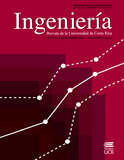Mostrar el registro sencillo del ítem
Avance del inventario estructural de edificaciones del cantón de San José
| dc.creator | Esquivel Salas, Luis Carlos | |
| dc.date.accessioned | 2021-10-13T13:44:23Z | |
| dc.date.available | 2021-10-13T13:44:23Z | |
| dc.date.issued | 2020-06 | |
| dc.identifier.citation | https://revistas.ucr.ac.cr/index.php/ingenieria/article/view/40469/42651 | |
| dc.identifier.issn | 2215-2652 | |
| dc.identifier.uri | https://hdl.handle.net/10669/84583 | |
| dc.description.abstract | Se presenta un avance del inventario estructural de edificaciones del cantón de San José, el cual podrá utilizarse en evaluaciones de riesgo sísmico. Este consiste en una caracterización estructural y determinación de la distribución espacial de las edificaciones ubicadas dentro del cantón. Para su generación, se contó con información de una muestra de 1 856 edificaciones seleccionadas por muestreo estratificado aleatorio con asignación proporcional, siguiendo el método denominado Mapeo Ambiental Rápido, desarrollado por el Centro Alemán de Investigaciones en Geociencias (GFZ – GeoForschungsZentrum). Entre los principales resultados se tiene que el 50% de edificaciones de la muestra son de mampostería de bloques huecos de concreto, confinada y reforzada, de 1 a 2 pisos con diafragma rígido. El otro 40% posee las mismas características pero con diafragma flexible. Además, el tipo de sistema resistente a cargas laterales más utilizado es el tipo muro (92%). | es_ES |
| dc.description.abstract | A preview of the structural building inventory in San José that can be used in seismic risk assessments is presented, consists in the structural characterization and spatial distribution of buildings inside the canton. For its generation, a sample of 1 856 buildings, selected by means of a stratified random sampling with proportional allocation was used, following the Rapid Environmental Mapping method, developed by the GeoForschungsZentrum (GFZ). Among the main results, researchers found that 50% of the buildings from the sample were of confined reinforced masonry, with hollow concrete blocks and with 1 or 2 storeys and rigid diaphragm. The other 40% hads the same characteristics but with a flexible diaphragm. Moreover, the most used lateral load resisting system was the wall type (92%). | es_ES |
| dc.language.iso | spa | es_ES |
| dc.source | Revista Ingeniería, vol.30(2), pp.103-119 | es_ES |
| dc.subject | Riesgo | es_ES |
| dc.subject | Terremotos | es_ES |
| dc.subject | Exposición | es_ES |
| dc.subject | Tipologías | es_ES |
| dc.subject | Edificaciones | es_ES |
| dc.subject | Matriz tipológica de edificios | es_ES |
| dc.subject | Risk | es_ES |
| dc.subject | Earthquakes | es_ES |
| dc.subject | Exposure | es_ES |
| dc.subject | Typologies | es_ES |
| dc.subject | Buildings | es_ES |
| dc.subject | Building typology matrix | es_ES |
| dc.title | Avance del inventario estructural de edificaciones del cantón de San José | es_ES |
| dc.title.alternative | Preview for the inventory in structural building in San José | es_ES |
| dc.type | artículo original | |
| dc.identifier.doi | 10.15517/RI.V30I2.40469 | |
| dc.description.procedence | UCR::Vicerrectoría de Investigación::Unidades de Investigación::Ingeniería::Instituto Investigaciones en Ingeniería (INII) | es_ES |


